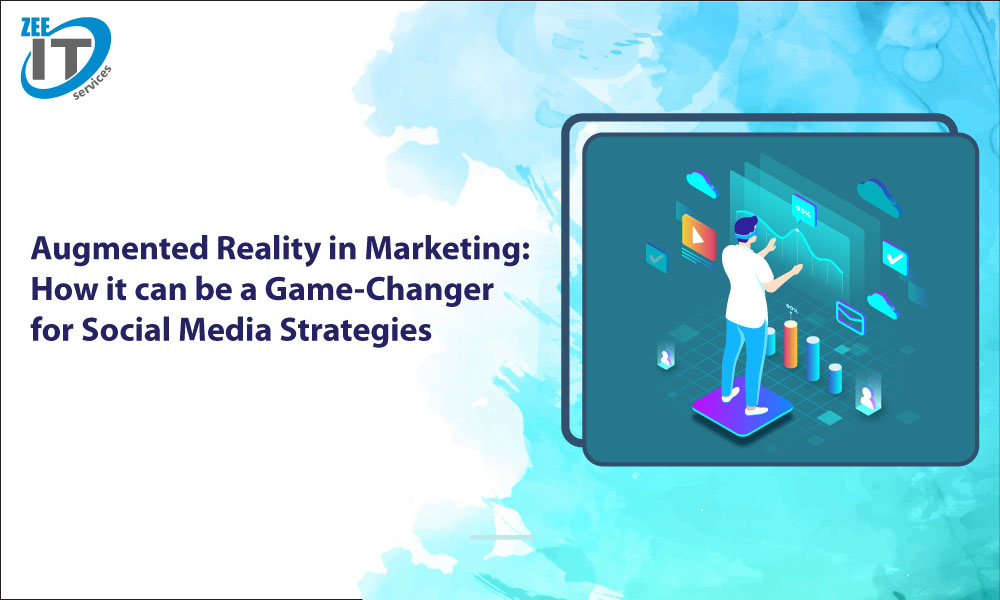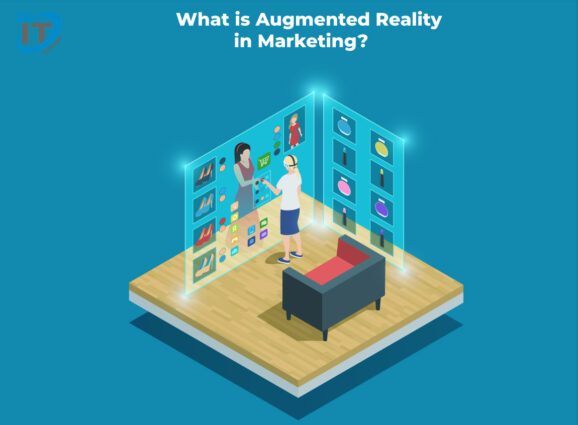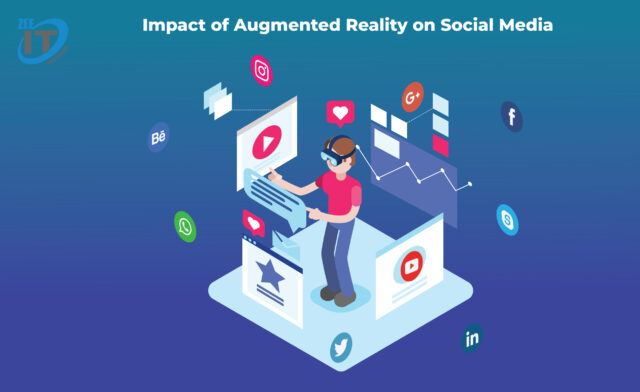A growing number of technology companies are already experimenting with augmented reality, or AR for short. An augmented reality system enhances real-world experiences by seamlessly integrating digital elements with the physical environment. Unlike Virtual Reality (VR), which immerses users in a completely simulated environment, AR overlays computer-generated information onto the real world. The market is forecast to grow by more than 220 billion USD between 2021 and 2028. According to Apple CEO Tim Cook, AR will be as common in our day-to-day lives as eating three meals a day. Moreover, It is estimated that 83.1 million Americans will be using augmented reality by 2024.
This technology is often experienced through devices like smartphones, tablets, smart glasses, or AR headsets. Common applications of AR range from gaming and entertainment to practical uses in industries such as healthcare, education, and much more. In addition to these applications, it is also beneficial for marketing as it enables brands to create immersive campaigns, allowing consumers to visualize products in their own spaces through augmented product previews or try-on experiences.
Furthermore, what are the implications of AR in social media, as well as how we implement AR in marketing? I have created this guide to help you understand more about the different aspects of augmented reality technology so let’s get started.
What is augmented reality in marketing?
In marketing, AR is used to develop captivating campaigns and promotional content that users can interact with in real-time. This technology allows consumers to engage with products or services in innovative ways, often using their smartphones or AR-enabled devices. By 2024, 1.73 billion people will use augmented reality on mobile devices.
In marketing, Augmented Reality can be used in the following ways:
- Immersive Product Experiences: AR enables consumers to visualize and experience products virtually in their environments. For instance, they can use AR to “try on” clothing or visualize furniture within their homes before making a purchase. Platforms like Shopify, Amazon, Flipkart, Alibaba, and others are positioning themselves as AR-enabled online stores. When purchasing clothes, cosmetics, accessories, or eyewear, AR walks customers through a variety of safety measures before they make a purchase.
- Interactive Advertising: AR transforms static advertisements into dynamic and interactive experiences. Brands can create AR campaigns that encourage users to engage with the content, whether it’s through scanning images, accessing additional information, or participating in gamified experiences.
- Enhanced Print and Packaging: Print materials, such as brochures or product packaging, can be enhanced with AR to provide additional information, videos, or 3D models when viewed through an AR-enabled device. Additionally, this adds a layer of interactivity to traditional marketing collateral.
- Augmented Retail Experiences: Retailers leverage AR to create augmented shopping experiences. Customers can use AR apps to view product details, receive personalized recommendations, and even navigate through stores with augmented wayfinding.
- Branded AR Filters and Lenses: Social media platforms incorporate AR filters and lenses, allowing brands to create custom overlays that users can apply to their photos and videos. Moreover, this not only enhances brand visibility but also encourages user-generated content, we’ll discuss it in detail next.
- Event Engagement: AR is used at events and tradeshows to create engaging experiences for attendees. Brands can use AR to showcase products, offer virtual demonstrations, and provide additional information in a visually compelling way.
- Storytelling through AR: Using AR, marketers can tell immersive and interactive stories that engage their customers. The use of this approach is particularly effective for delivering brand narratives and messages to consumers in an engaging and memorable manner.
Components of Augmented Reality:
Augmented Reality (AR) technology involves a sophisticated interplay between hardware and software that works seamlessly together to provide immersive and interactive experiences. In order for digital information to be successfully integrated into the real-world environment of the user, these components need to be in place. Furthermore, the following are the fundamental elements of AR:
Sensors:
Sensors act as the eyes in Augmented Reality, capturing and interpreting the physical environment. These sensors, including cameras, accelerometers, and gyroscopes, work together to provide the user with a clear perspective on their surroundings. The data collected becomes the foundation for AR applications, enabling precise augmentation based on real-world inputs. Moreover, the most common sensors are:
- Camera Sensors: Cameras capture the user’s surroundings, providing a live feed that serves as the foundation for overlaying digital content in the real world.
- Depth Sensors: These sensors gauge the distance between objects in the physical environment, enhancing the accuracy of digital overlays.
Processing Unit:
A robust processing unit is essential for real-time data analysis and rendering. This unit interprets information from sensors, calculates spatial relationships, and ensures the seamless integration of virtual elements. Moreover, An AR application’s fluidity and responsiveness are determined by the efficiency of the processor, so it plays an important role in the user experience.
Display:
The display component serves as the bridge between the physical and digital domains. High-resolution screens, often found in AR glasses, tablets, smart glasses, or smartphone screens, play a pivotal role in seamlessly integrating virtual elements into the user’s field of vision. Clarity and responsiveness are paramount, ensuring a captivating and realistic AR experience.
Projection Technologies:
In some AR implementations, projection technologies are used to display digital information directly onto physical surfaces. In addition, this eliminates the need for a separate device screen and enhances the overall user experience.
Tracking Mechanisms:
- Positional Tracking: This technology monitors the user’s movement within a physical space, ensuring that digital elements align accurately with the real world as the user navigates.
- Object Tracking: AR systems can track specific objects or images, triggering digital content to appear when the device recognizes a predefined target.
Connectivity:
The interconnected nature of AR devices relies heavily on robust connectivity. Whether through Wi-Fi, Bluetooth, or 5G, a stable and high-speed connection is imperative for real-time communication between the device and external servers. Additionally, this connectivity not only enhances the user experience but also facilitates the exchange of data crucial for AR functionality.
Augmented Reality Software:
In the dynamic world of Augmented Reality, software acts as the storyteller, shaping the narrative of the augmented experience. AR applications leverage advanced algorithms for image recognition, spatial mapping, and rendering, creating a cohesive and responsive AR environment to interpret sensor data, align virtual elements with the real world, and ensure a harmonious integration of the two realities. Moreover, Regular updates and advancements in AR software contribute to the continual refinement of the user experience.
Impact of Augmented Reality on Social Media
Augmented Reality (AR) has emerged as a transformative force in social media, reshaping how we connect, engage and share our digital experiences. Business and content creators will benefit from this paradigm shift not only because user interaction is enhanced but also because new opportunities will open up for them. Furthermore, let’s take a deeper look at the profound impact Augmented Reality has on social media.
Interactive Filters and Lenses
AR-powered filters and lenses add a dynamic layer to photos and videos, allowing users to engage with content in real time. From playful animations to branded overlays, these interactive elements captivate users, encouraging them to spend more time on the platform.
Snapchat was the first app to integrate augmented reality (AR) filters and lenses, which overlay elements on users’ faces, such as sunglasses, mustaches, rainbows, or bunny ears, so they can see those characteristics moving with them while taking pictures or recording videos. Additionally, with the use of augmented reality (AR) technology, Snapchat may become an e-commerce platform in the near future.
Virtual Try-On Experiences:
Retail brands leverage AR to enable virtual try-on experiences. Users can try out products, such as makeup or clothing, in real-time through their device’s camera, creating a personalized and immersive shopping experience.
Among the brands Snapchat has already collaborated with are American Eagle and Gucci to offer try-on experiences within the app. In the future, the company plans to expand to other businesses. According to Snapchat, one of the benefits of virtual try-on rooms is that they may lower return rates as users can examine items before they take out their credit cards.
Immersive Brand Storytelling
Social media platforms thrive on visual content, and AR takes visual storytelling to unprecedented heights. Users can now weave narratives by integrating virtual elements into their real-world surroundings. This not only adds a layer of creativity but also provides a unique and personalized touch to content, making it more shareable and memorable.
Facebook claims that over 1 billion stories are shared daily by members of its app family, which includes Instagram and Facebook. Before sharing their Stories with friends and family, a lot of these users add amusing animations or filters to make them uniquely their own.
AR-Powered Advertising
Advertisers leverage the immersive nature of AR to create interactive and memorable campaigns. Augmented reality ads enable users to engage with products in real time, enhancing brand recall and user engagement. As users actively participate in the ad experience, the traditional boundary between advertising and content blurs, creating a more organic and user-friendly promotional landscape.
AR-enhanced Content Creation
In the competitive realm of social media influencers, those embracing AR gain a competitive edge. From makeup tutorials with virtual try-on features to travel vlogs enhanced with augmented overlays, influencers leverage AR to captivate their audience. Additionally, this not only boosts their content quality but also establishes a forward-looking and tech-savvy image.
Building Personal Brands with AR
Augmented Reality becomes a powerful tool for individuals looking to build and showcase their personal brand. The ability to create unique and branded AR content sets influencers and content creators apart, fostering a distinct online identity. This differentiation is crucial in a saturated social media landscape.
Challenges and Solutions in AR Marketing
Device Compatibility
One of the challenges in AR marketing is ensuring compatibility across various devices. Overcoming technical limitations involves developing AR content that is accessible to a broad audience. This inclusivity ensures that users with different devices can engage with AR experiences, expanding the reach of marketing campaigns.
Bandwidth Considerations
AR content often requires significant bandwidth, posing challenges for users with slower internet connections. Overcoming this hurdle involves optimizing AR content for smooth performance across varying bandwidths. In addition, by prioritizing efficiency without compromising quality, brands can ensure that their AR campaigns reach users regardless of their internet speed.
Addressing Privacy Concerns Related to AR
Privacy concerns are paramount in the digital age, and AR is no exception. Brands must address these concerns by being transparent about how user data is collected and utilized in AR experiences. Moreover, implementing robust data protection measures builds trust with users, assuring them that their privacy is a top priority.
Opt-In Mechanisms
To alleviate privacy concerns, incorporating opt-in mechanisms is crucial. Users should have the choice to engage with AR features willingly. Providing clear options for opting in or out of AR experiences empowers users, fostering a sense of control over their digital interactions.
Strategies for Mitigating Resistance to AR Adoption
Education and Awareness
Resistance to AR adoption often stems from a lack of understanding. Brands can mitigate this resistance by investing in educational campaigns that explain the benefits and safety measures associated with AR. Moreover, by dispelling misconceptions, brands pave the way for a more receptive audience ready to embrace AR technology.
Gradual Integration
Rather than overwhelming users with abrupt changes, gradual integration is key. Brands can introduce AR features incrementally, allowing users to acclimate to the technology at their own pace. Additionally, this approach minimizes resistance and fosters a positive reception to AR within the target audience.
Frequently Asked Questions
What is Augmented Reality (AR), and how does it apply to marketing in the context of social media?
Augmented Reality (AR) is a technology that overlays virtual elements onto the real world, enhancing the user’s perception and interaction with their environment. In marketing, particularly in social media, AR is employed to create immersive and interactive experiences. This can include features like virtual try-ons, interactive filters, and engaging lenses that users can experience through their mobile devices.
How can integrating AR features into social media platforms enhance user engagement?
Integrating AR features into social media platforms enhances user engagement by offering a more interactive and visually compelling experience. Users can go beyond passive consumption of content, actively participating in campaigns through AR filters, lenses, and gamified experiences. Moreover, this increased engagement not only captures attention but also fosters a deeper connection between the brand and the audience.
What are the benefits of creating interactive AR filters and lenses for social media marketing?
Creating interactive AR filters and lenses elevates the user experience by providing a personalized and fun interaction with the brand. Users can try virtual products, explore branded environments, and share their experiences on social media, effectively becoming brand advocates. Additionally, this user-generated content acts as authentic endorsements, amplifying the brand’s reach and fostering a sense of community around the brand.
Can Augmented Reality be seamlessly integrated into existing social media strategies, and how can businesses ensure a cohesive brand experience?
Yes, Augmented Reality can be seamlessly integrated into existing social media strategies. Businesses can ensure a cohesive brand experience by collaborating with AR developers to guarantee smooth integration. Whether it’s a sponsored AR filter or a branded lens, the transition should be seamless, providing users with a consistent and enjoyable brand experience.
How can Augmented Reality contribute to brand visibility and long-term brand recall on social media?
Augmented Reality contributes to brand visibility by creating memorable and shareable experiences. Users are more likely to share AR content on social media, turning them into brand advocates and amplifying the reach of marketing campaigns organically. Moreover, the interactive and visually appealing nature of AR experiences enhances brand recall, ensuring that the brand stays in the minds of the audience for the long term.



